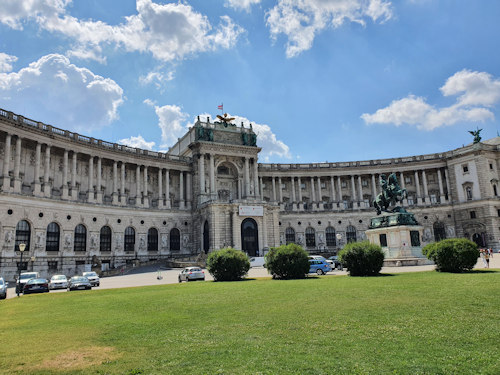
If there was one day Austria would like never to have happened, it might be March 15th, 1938. A distinct low point for the country, however you look at it. The day Hitler proclaimed the Anschluss with Germany from the balcony (actually a terrace) of the Neue Burg.
- Terrace still exists
- …inaccessible to the public
- Debate continues on what to do with it
- Take a guided walking tour* around WWII sites & memorials
- See also:
The Darkest of Days

(The infamous location)
The last big extension to the Hofburg home of the ruling Habsburg dynasty in Vienna was the Neue Burg wing that curves along one edge of the huge Heldenplatz square in Vienna’s centre.
The end of WWI saw those Habsburgs turn from rulers into former rulers. Austria itself morphed from the heart of an empire into a small republic facing significant economic and social challenges.
As a result, money and motivation for representational building projects was scarce, so it would take a while before interior work on the Neue Burg finished.
One part of the wing already completed, however, was the large terrace or Altan, built above the main entrance that projects out from the front of the building.
Given the huge space in front of it, politicians put the terrace to use as a place to address open-air gatherings in the years following the war.
None of those appearances have really remained in Austria’s collective consciousness. With one tragic exception: Hitler’s speech on March 15th, 1938.
Plenty of other resources can explain the complexities of the history of the 1930s far better than me. Suffice to say, Nazi Germany (and its supporters in Austria) sought the merging of the two nations. Others (including many homegrown right-wing extremists in Austria) did not.
Things came to a head on March 12th, 1938 when German troops entered Austria en masse, accompanied by thousands of police officials. Nazi adherents had already paved the way internally.
The writing was on the wall for Austrian independence.
The troops, the immediate brutal crackdown on opposing voices, a lack of any cohesive concerted opposition, and plenty of local enthusiasm for a merger meant Austria fell to Hitler and Germany almost immediately. And with little bloodshed (that would come later through Nazi rule).
And so we reach March 15th.
On that day, Hitler stood on the Neue Burg terrace in a city swathed in swastikas and announced the Anschluss…that his home country was now part of Germany.
As such, the Neue Burg terrace is often referred to as “Hitler’s balcony”.
On April 10th, not long after Hitler’s speech, a referendum found near 100% of the country in favour of the change. Needless to say, that referendum was not held in circumstances conducive to a free and fair vote.
The day arrived on a wave of mass propaganda, for example. Jews could not participate. And those who voted no or wanted to cast their vote in secret risked persecution.

(The Neue Burg and Heldenplatz today)
Given the unwelcome association, the terrace has remained almost always off limits to the public, cloaked in a metaphorical darkness that nobody wants to penetrate; the shadow cast by Hitler’s speech on March 13th is long.
The infamy of that occasion and location perhaps comes from two sources.
First, the presence of the monstrous dictator, the political merging of Nazi Germany with Austria, and all the consequences of that for the millions that later suffered: either directly through, for example, torture and murder or indirectly through, for example, the ravages of war.
Second, a prevailing image from that day is one of an enthusiastic crowd.
History is obviously nuanced, and not everyone on Heldenplatz would have shared or even understood Nazi ideals. Many simply hoped for better days ahead. And, of course, let us not forget those who stayed away.
But the sight of over 200,000 Austrians cheering on Hitler was, let us simply say in retrospective understatement…not a good look.
And today’s balcony?
As mentioned, you can’t go out onto the balcony…only view from it below.
The space behind the terrace inside the Neue Burg is used by the HDGÖ (House of Austrian History) for special exhibitions and named after the Jewish musician Alma Rosé (1906-1944). Rosé died in the Auschwitz-Birkenau concentration camp and led an orchestra there formed of female prisoners.
Debate continues as to what to actually do with the terrace itself, even 80 years after its moment of infamy.
Many voices would like to see the location reclaimed for a more positive association. The HDGÖ have also encouraged the public to consult on the fate of “Hitler’s balcony”.
Heldenplatz itself, for example, has become largely rehabilitated. It hosts, for example, the Festival of Joy each May 8th as an act of remembrance for victims of national socialism and to celebrate victory over the Nazis.
How to get there
Follow the travel tips for the House of Austrian History.
Address: Neue Burg, 1010 Vienna